Attic ceiling: choice of material and design

When it comes to the attic, one immediately remembers the attic spaces located on the last floors with an inclined ceiling. Sometimes they are used as closets, where unnecessary things are stored for years. But you can find a more successful application for this room and make a living room out of it.



Design features
Attic spaces were first used in 1630 in France, when François Mansart adapted the space for housing. In honor of the architect Mansar, the attic floors under the broken roofs began to be called the attic, where the poor lived. Recently, increased attention has been paid to the arrangement of attics.
The owners of such premises are often confused because they do not know how to use it correctly and functionally.
The solution to such a question should be approached responsibly, because the attic has its own characteristics.

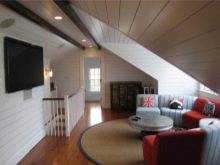

The attic can be varied in shape - triangular or broken, symmetrical or asymmetrical. Using this peculiar zest, you should properly arrange the attic floor. Here you can arrange a separate office for work or create a nursery or dressing room with the help of pyramids.




When finishing the ceiling, one should take into account the quality of its insulation. It is important to immediately insulate the ceiling, only after that they begin to finish it. You may have to face difficulties due to the broken geometry of the roof, but you should not be afraid of bevels, modern materials allow you to work in different conditions.
When choosing a finishing method for the attic, one should take into account what the room will be intended for, its style, the shape and height of the roof.

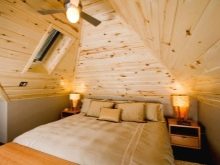
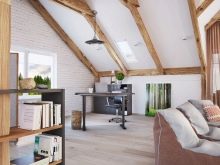
Requirements for the premises
Getting started, you should study the requirements of SNiP 2.08.01-89, with particular attention to the points that speak of safety, compliance with sanitary and hygienic standards.
The attic floor can be located in any building, although there are objections to arranging it in a wooden house. When using a special impregnation for wooden structures and with proper protection, if the height of the building does not exceed 75 meters, it is allowed to use wooden structures.



When working in attic rooms, it should be borne in mind that the walls in the room can be 1.5 meters high. For an ordinary room, the optimal ceiling height should be at least 2.5 meters; in the attic, the ceiling may have a lower height. The ceilings in the attic floors have a complex structure, but using certain methods, you can independently equip a comfortable home.
Drafts and blowing are frequent in attic rooms, and in order to avoid them, work should be carried out to seal the seams, heat the room, install windows with a coating that retains heat in the room.

Materials and design
Attic floors are different in height, decoration, arrangement of windows, these can be rooms with a ceiling sloped to one or both sides. For each of these rooms, you should choose suitable options and sheathe the room with the selected materials.



Most often, when lining the ceiling, the following traditional materials are used:
- lining;
- imitation of a bar;
- block house;
- drywall;
- sanding plywood;
- cork panel;
- decorative plaster;
- stretch ceiling.
The choice may depend on the preferences of the owner of the premises, financial capabilities and the style in which the room will be decorated.


Traditional materials for cladding are best used when choosing a classic style, Provence or country. When decorating a room in a more modern high-tech style, other materials will do.


Plasterboard finish
One of the main materials for interior decoration should be called drywall. The attic room can also be sheathed with material. Choosing it to work with the ceiling, you should take into account that you need a moisture-resistant material.
Plasterboard ceiling device is carried out independently or use the help of specialists. Using drywall, it is possible to make multi-level ceilings, divide the room into zones. The material has good sound insulation, fire resistance and is easy to work with. With this finishing option, you can hide various irregularities and insulation.
Drywall has a significant drawback - if a large amount of water gets on it, depressurization may occur and the ceiling will have to be redone. Using it in work, you should make sure of good waterproofing.



The sheets should be fixed to the ceiling lathing.
After working with drywall, finishing work should be carried out:
- align the joints;
- paint the surface;
- stick wallpaper;
- use other types of decor.


Choosing a ceiling plinth
Upon completion of the work, you should choose a ceiling plinth, it will give clarity to the lines and the ceiling will look more beautiful.
The easiest and most inexpensive option to use is a foam plinth. It can be easily cut with a knife, but it should be borne in mind that the material has low mechanical strength.
You can choose expanded polystyrene, it will be stronger than a foam baseboard, but the price of such a material is higher, although you cannot rank it as too expensive. Styrofoam and expanded polystyrene are fixed with glue or putty. These materials allow you to make the ceiling quickly, without spending significant amounts of money on the material.
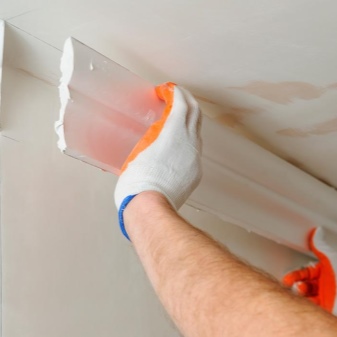

When choosing wooden moldings, you should know how to properly attach them to the surface. Working with wooden baguettes is not as easy as it might seem at first glance. The material is more difficult to handle and to adjust corners, any inaccuracies or blemishes will be visible. In addition, the tree can be subject to rotting, mold, and bug attacks. After applying an antiseptic treatment and a couple of coats of varnish, rot and mold can be avoided.
To fix wooden skirting boards, you need to work with a puncher and fix them to the fasteners. It should be noted that wooden moldings are the most expensive option for ceiling plinths and are usually used in rooms with appropriate framing.


Reed canvas
You can decorate the ceiling in the attic with reed linen. Walls and ceilings are trimmed with this material, it can become the basis for the manufacture of various curtains and blinds.
This material is versatile, which allows it to be laid on any surface. Reed canvases can be used in rooms with high humidity. The material absorbs excess moisture well, which contributes to a good indoor climate.
Liquid nails and glue are used to mount the reed canvas. The product can be easily cut with a sharp knife or hacksaw. Such a canvas can last a very long time if you clean it with a vacuum cleaner or wipe it with damp paint.

Chipboard sheets
As an alternative to drywall, chipboard sheets are used for finishing the ceiling. It is used if further surface painting is planned or wallpaper will be glued. Using chipboard sheets during repair work, you can complete the work as soon as possible.

Open beams
With the help of open beams, you can give the attic a certain style.The work will require financial investments from the owner of the premises, therefore, before starting work, it is better to study the features of working with the material.
Coniferous logs are used for ceilings., which are cleaned and processed with special means, which ensures their durability and gives the product a beautiful appearance.


You can cover the entire ceiling with open beams or combine them with various materials using textiles, stone, ceramics, which will allow you to design ceiling structures in different styles.
For the attic, it is worth using false beams, they are empty inside, so they weigh a little, it is much easier to work with them than with ordinary beams.


Laminate
Initially, laminate was used for flooring, but gradually came to be used for interior decoration. Even a novice builder can decorate the ceiling with laminate, you just need to prepare a hammer and find an assistant for yourself.
To finish the ceiling with laminate, preparatory work should be carried out and the ceiling should be cleaned from the remains of plaster. Next, mark the ceiling, taking into account the size of the laminate. The lathing begins with laying the lags, then the crossbars are laid. A metal profile or a wooden frame is placed under laminate ceilings. For attic rooms, it is advisable to use a wooden frame.

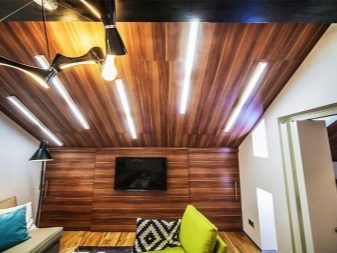
Lining
For lining the ceiling in the attic, lining may be suitable. The material is affordable and has excellent characteristics; it is recommended for use in residential premises. Using the lining, you can achieve an imitation of natural wood, which will allow you to make the attic stylish and beautiful at the lowest cost.
For finishing the ceiling, use ordinary lining, which is pre-sanded, or polished Euro lining. You should choose light colors, then the attic room will immediately become visually larger, more spacious and brighter.

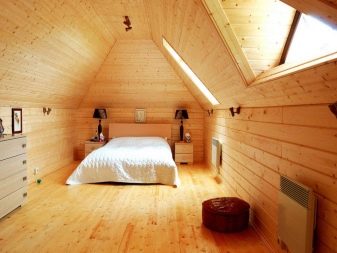
Timber imitation
You can decorate the walls and ceiling using an imitation of a bar. This is a finishing material that consists of wood.
To finish the ceiling with imitation of timber, you should:
- carry out preparatory work and make the crate;
- fix the imitation timber on the ceiling using self-tapping screws or clamps;
- at the final stage of work, a special coating, impregnation, paint, varnish, wax are applied.

Stretch canvases: pros and cons
When installing stretch ceilings in the attic, you should study all their positive and negative sides. Using stretch canvases, you can make an interesting design of the room, make it in a certain color scheme, stretch it at different angles, make different shapes, and set it at different levels. Thanks to this coating, the room will immediately become richer and brighter.
Positive sides when installing stretch ceilings:
- the material is safe, does not have an unpleasant odor;
- does not burn;
- long service life - up to 15 years;
- stretch ceilings are installed very quickly, without dirt and dust.

Negative sides when installing stretch ceilings:
- the material is afraid of sharp objects; when handling them, you should be careful not to spoil the surface;
- with temperature drops, material deformation is possible.


Lighting
The correct lighting of the attic depends on how comfortable it will be. Using lamps, you can not only achieve optimal illumination of the room, but also emphasize the chosen style.
For low ceilings, original lamps, sconces and floor lamps will be the best choice. A chandelier in such a room would be out of place. In the attic, you can abandon general lighting and focus on local lighting, while focusing on a specific place in the room.

To achieve the best effect, spotlights should be directed at the wall, so the room will visually become more spacious. The same effect can be achieved by placing the fixtures around the perimeter.A large mirror in the attic will help maximize the room.
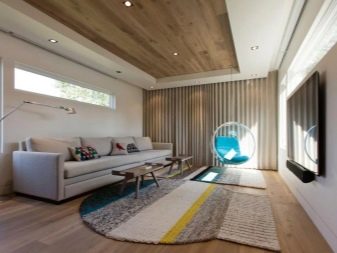

Beautiful examples in the interior
- When decorating the ceiling, you should decide for what purposes the room is intended. In the attic floors, a dressing room with many wardrobes, shelves, and boxes can be a good option. Here you can store things that will be neatly folded and hung in order.
- Thanks to modern technology and materials, you can turn the attic into an ordinary living room. A children's room located in the attic will allow the child to spend time with his friends without disturbing the adults. Here you can create a special fairy-tale world for children. Every day spent in the children's room will be interesting and amazing.


See the next video for more on this.













The comment was sent successfully.